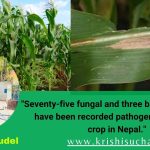Existing Approaches of Seed Production Technology of Maize in Nepal & Their Achievements
Adoption of new technologies i.e technology dissemination is underway through different community-based approaches mainly DISSPRO, CBSP and PVS. Community mobilization through formation of group and cooperatives and technology transfer through the agriculture extension education (demonstrations, training, mini-kit/IRD-kit and visits) are keys to increase technology adoption and increase food production.
Participatory Variety Selection (PVS):
PVS is the selection of farmers’ preferred varieties of different crops by themselves in their own fields under their own management. The main objective of PVS is to overcome the bottleneck of the diffusion of farmers’ preferred varieties and to provide varietal selection options to fit in the niche environment. Once the variety is identified, farmer-to-farmer dissemination of PVS variety is the most common process of varietal diffusion. Participatory research can be used to empower farmers and promote development in farmers’ communities. It can also be used to increase the efficiency of formal breeding programs in developing and popularizing varieties suitable for resource-poor farmers. The rejection of released varieties by farmers, who do not adopt them, and the rapid and high adoption by farmers of non-released varieties are the successful examples of PVS. The PVS approach helps to identify farmers’ preferred Varieties in their own field under their own management within a possible shortest period of time and provides varietal selection options using mother-baby trials. Collaborative participation allows farmers to decide overall which variety/varieties they prefer as a simpler and more effective solution.
District seed self sufficiency program (DISSPRO)
DISSPRO for the first time was envisaged in the Ninth Five Year Plan (1998/99 to 2001/03). Basic underlying principle of DISSPRO is to encourage and strengthen local level seed production and marketing to meet local and district level seed demand and, develop small scale seed entrepreneurship and facilitate the development of huge seed market in future; create awareness about the quality seed among the farmers; disseminate and multiply newly released varieties. Technology dissemination programs including training, 25 % subsidy in the source seed, provision of seed fund and seed revolving fund of Rs 5000-60,000, respectively for each group and provision of Rs.200/ha for control of insects pests are major support programs. Formation and strengthening of farmers’ groups to produce quality seed of desired verities and in required quantity is a major policy strategy of DISSPRO. To assure supply of source seed as per of the demand for which a seed balance sheet is prepared each year. It is becoming a very effective approach for seed sufficiency at local level. For the Last two years, CDD is implementing a more intensive package of support for the commercial scale seed production in different 13 districts (11 terai and 2 hill) in 500 ha of area.
Features of DISSPRO:
- Supply driven (e.g. identification and seed multiplication of farmers’ preferred varieties) program
- Scarcity of source seed of major cereals especially rice, oilseed and pulses .
- Existing seed production technology dissemination system is not sufficient .
- Seed quality control mechanism is not easy and effective .
- Participation of stakeholders is encouraging .
- Support for community based infrastructure from the government as well as private sectors/NGOs is nominal .
- Seed marketing and market information system is very sluggish .
- Strengthening of farmers’ groups and farmers’ cooperatives needs to be incorporated in the program and
- Agro-vets and seed traders’ involvement for sustainable seed marketing is felt .
Community based seed production (CBSP)
CBSP is an approach to produce seed of farmer’s preferred varieties selected through PVS. In 1999, Hill Maize Research Program (HMRP)/ CIMMYT for the first time worked with the DoA/ CDD to improve food security through increased maize production in the four hills and mountain districts of Nepal. In the second phase (year2004-2008) number of districts was increased to 11 for the same program by HMRP. After successful completion of the first and second phases, third phase of this project (2008 to 2010) has been implementing emphasizing the technology transfer to the poor and socio-economically disadvantaged communities in the hills and mountains in Nepal (NMRP 2008). CDD in collaboration with hill maize research program (HMRP/CIMMYT) and some non-governmental agencies are executing community-based seed production (CBSP) program in maize in 25 hill and mountain districts. Participatory varietals selection and participatory technology development (PTD) using mother/ baby trail concept under CBSP are major technical interventions. In 2007, 105 mt of maize seed was produced from 11 districts while for the for the year 2008, it was 243 mt from 150 ha area and in 2009, it was 427.5 mt from 231 ha from 25 districts (CDD, 2009a).
Features of CBSP:
- A cheapest and successful intervention for sustainable food production
- Location specific maize varieties identified and technology generated through PVS and PTD
- Quality seeds produced and supplied at grass root level
- Participation of the multi- stakeholders in maize technology research and extension create enabling environment to realize the interest of each actor in a coordinated way
- PVS/ CBSP has increased access of the poor, women and disadvantaged groups for the technology and inputs
- Focus on the marketing and development of community structures for seed storage and marketing are insufficient
- Enterprising community groups in seed production, processing, storage and marketing are still weak in most of the cases
- Increase in maize yield by 17% was realized in DoA/ CDD projects which areas mainly due to use of the quality seed of the improved variety and changes in technology
- Through PVS (mother-baby trial approach) farmers preferred varieties were selected and these were put into CBSP which facilitated the availability of the quality seed to the farmers.
- Rampur Composite, Manakamana 1, Manakamana 3, Deuti, Shitala varieties were released by NARC which has helped to increase maize production in the country.
Conclusion
Despite four decades of endeavour towards maize production improvement the progresses are insignificant. The national annual seed replacement rate (SRR) for maize is only 5.98 % and the national average productivity is 2205 Kg//ha. The seed supply from the public sector for maize is less than 1% and adoption of the improved maize varieties is very low. DISSPRO was designed to transfer seed production technologies their by producing quality seeds and marketing at the community level. CBSP works as that of DISSPRO and it could be regarded as modified and improved version of DISSPRO. The main beauty of this approach is that it is cost effective, have good community participation and empower the disadvantaged groups. PVS has been proved as an important approach and tool for variety selection (technology development) and technology verification. So integration of all these approaches could be the best effective for participatory technology development, verification and dissemination of sustainable seed production and marketing at community level.
Writer: Sushant Ghimire (Student,Bsc Ag, Paklihawa Campus)

 एउटा यस्तो विषालु भ्यागुता, जसको मुल्य नै पर्छ ३ लाख, जान्नुहाेस्
एउटा यस्तो विषालु भ्यागुता, जसको मुल्य नै पर्छ ३ लाख, जान्नुहाेस्  भोलि र पर्सि बालबालिकालाई भिटामिन ए खुवाइदै
भोलि र पर्सि बालबालिकालाई भिटामिन ए खुवाइदै  खगराज अधिकारी गण्डकीको मुख्यमन्त्री नियुक्त
खगराज अधिकारी गण्डकीको मुख्यमन्त्री नियुक्त  सुनसरीमा दुवै पक्षबीच सहमति, कर्फ्यु खुकुलो हुदै
सुनसरीमा दुवै पक्षबीच सहमति, कर्फ्यु खुकुलो हुदै  स्टेफेनको शतकमा आयरल्याण्ड वोल्भ्सले नेपाल ए लाई दियो २८५ रनको लक्ष्य
स्टेफेनको शतकमा आयरल्याण्ड वोल्भ्सले नेपाल ए लाई दियो २८५ रनको लक्ष्य 


